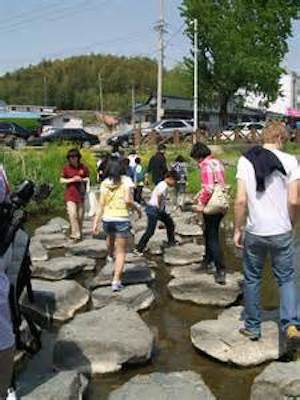An acquaintance asked me the other day, “Don’t you miss eating normal food? I could never eat such a restrictive diet,” her expression filled with a mix of indignation and curiosity.
We all have our different reasons for why we eat what we eat. Some of us use food as a way to find comfort (fresh baked cookies to cure the blues), while others luxuriate in the physical pleasure of experiencing exotic flavors and textures. There are those that focus on what they can’t eat in order to avoid an allergic reaction or lose those unwanted extra pounds. Food choices are emotional decisions, a way to fill the void when we are feeling lonely or insecure, or as a reward to celebrate an accomplishment.
Just like all the different ways we choose what we eat, there are many ways to be vegan. The interpretations range in extremes from advocating animal rights, to eating imitation meat and dairy replacers in order to hold onto the familiar, to the exclusion of all but raw organic whole foods. For me, being vegan is about consciously choosing what I eat, focusing on foods rich in nutrients that will support my body and its healing process.
A friend once asked me, “do you find any pleasure in food, or is it all about health?”
Through the process of helping my husband, Stefan, use nutrition to reverse his aggressive prostate cancer, we learned the importance of conscious eating and taking advantage of the vital role food plays in every aspect of our health.
One of the most important lessons we learned was that everything we eat is significant and directly affects the health of our body. Our bodies are made up of about ten trillion cells that require specific nutrients in order to function to their optimal capacity so they can perform the jobs they were created to do. If we don’t provide them with what they need, they begin to break down. It’s that simple.
I’ll be honest, in the beginning of our pursuit to cure Stefan’s cancer it was all about restrictions: no meat, dairy, processed foods, sugar. The list seemed endless as we realized how dependent our diet was on unhealthy foods. When many of our first attempts at creating edible meals failed miserably, we questioned whether Stefan could continue eating such a restrictive diet, and our daughters and I could support him through this process. Conscious eating required time, energy and creativity. All of which we had on short supply. There were nights I cried over another barely edible meal and the fear whether it was all even worth it. Could food really provide a cure? But we didn’t give up. Slowly, we developed a repertoire of dishes that were satisfying and nutritious.
We realized that in order to be successful we needed to experience a paradigm shift about how we thought about what we ate and why we ate it. We could no longer use our traditional comfort foods to fill our emotional needs. We needed to rebuild our relationship with food enjoyment and that was going to take time, one step at a time.
As they say, “knowledge is power”. As I learned more about using food to support the body’s healing process, I began to experiment and incorporate new foods into our diets. We discovered that, as our bodies released the sugars and additives we had been accustomed to, our tastes started to shift and we began craving the fresh crisp textures of a garden salad, the earthy goodness of sautéed greens, and the complex flavors of spices without the need of added sugar and excessive salt. We found new “comfort” foods that were satisfying and healthy.
As an added bonus, we witnessed the reversal of Stefan’s cancer! Drug free, no surgeries, no chemo, and no radiation! We were empowered; there was no turning back to the old way of eating. Pastries and ice cream lost their appeal. Chips and dip no longer made our mouths water. There was a new feeling growing inside us; we felt better, healthier, stronger, empowered.
This was our journey. Each person’s experience is unique. As you seek out your path, remember:
Step 1: “Practice progress, not perfection” – Give yourself permission to make mistakes. Forgive yourself when your steps fall backwards, and then pick yourself up and start again. Changing habits and behaviors is extremely difficult. It takes perseverance and repetition. Don’t give in to that voice in your head that says it’s too hard and you’re not strong enough. You CAN do it! Allow the possibility into your reality!
Step 2: Set time aside to experiment with new foods and cooking techniques. It’s through trial and error that we do our best growing. The easiest way to transition to vegan is to allow the time in your life to begin. Start by trying one new recipe and/or new food a week. Go to the library and check out some cookbooks, cruise the internet for recipes, or try some of ours.
Step 3: Take it one step at a time. It’s easy to get overwhelmed when you look at the big picture. Very few people have the tenacity to make changes the “all or nothing” way. Focus on changing one food behavior at a time; such as eating healthier deserts and/or snacks. Healing and change takes time. Set yourself up for success by setting reasonable goals that fit your lifestyle and personality.
If we can do it, you can do it!
Read Our Journey with Prostate Cancer
Contact us and share your story
Visit our website to learn more about the relationship between food and your health.


Encouraging post. We have been on a plant-based diet since last June, “cheating’ vegans before that, vegetarians before that. Our progress stepped up with my husband’s diagnosis of myeloma. Each new day invites us to taste something new. Recently, a friend invited us to dinner and used Recipes from this site for the meal: Vegan Lentil Soup, Fennel Salad with blood oranges, dates, macadamia nuts and toasted almonds, Felafel in pita bread with trimmings, hummus, and lemon-tahini sauce, Berry Sorbet with bananas and fresh raspberries. Yum. The “ohs and ahs” began with the soup and continued throughout the meal: “I thought the food would be bland.” “I want more of this.” I was blown away at the other guests’ response: They were actually surprised by the colorful plates before them, the simply good taste and complexity of each dish.
This website helps all with a place to start to change educate our taste buds. Thank You once again.